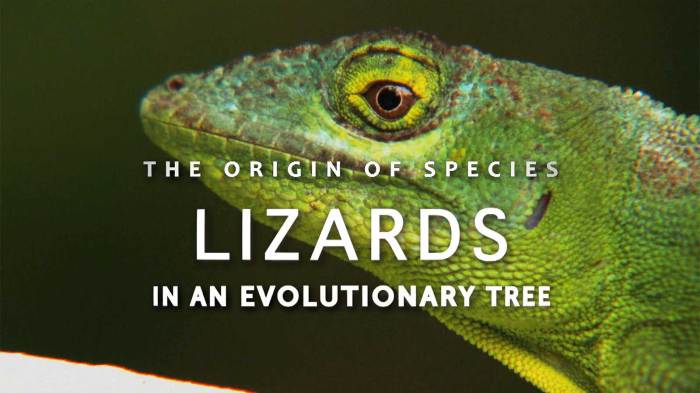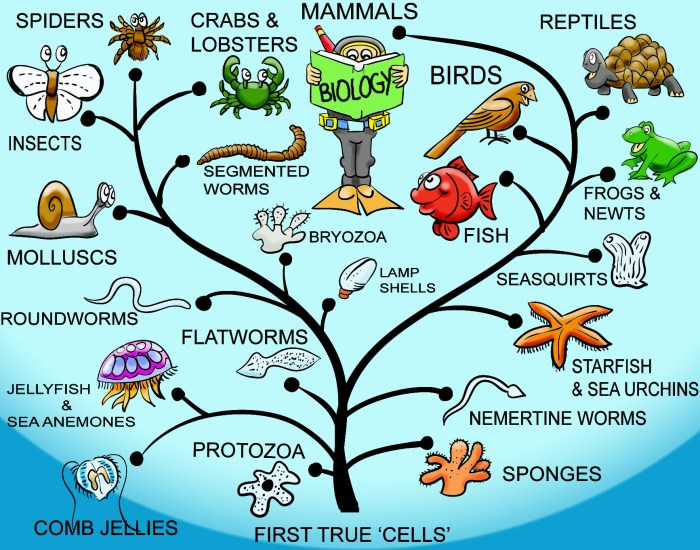The Origin of Species: Lizards in an Evolutionary Tree Answers delves into the captivating realm of lizard evolution, tracing their remarkable journey through the annals of time. From their humble beginnings to their diverse adaptations, this exploration unravels the intricate tapestry of their evolutionary history, providing profound insights into the forces that have shaped their existence.
This comprehensive analysis delves into the evolutionary tree of lizards, showcasing the major branches and key evolutionary events that have shaped their diversification. It examines the diverse adaptations that have enabled lizards to occupy a wide range of habitats, exploring the role of natural selection in driving these adaptations.
Furthermore, it investigates the significance of molecular data in reconstructing the evolutionary history of lizards, highlighting the insights gained from DNA and protein sequences.
1. Evolutionary Tree of Lizards: The Origin Of Species: Lizards In An Evolutionary Tree Answers

An evolutionary tree, also known as a phylogenetic tree, is a diagram that represents the evolutionary relationships between different species or groups of organisms. It is based on the concept of common ancestry, which states that all living organisms share a common ancestor from which they have evolved over time.
The evolutionary tree of lizards is a complex and diverse one, reflecting the long and varied evolutionary history of this group of reptiles. Lizards are thought to have evolved from early reptiles around 250 million years ago, and they have since diversified into a wide range of forms and adaptations.
The major branches of the lizard evolutionary tree include the iguanians, the geckos, the skinks, the snakes, and the amphisbaenians. Each of these groups has its own unique characteristics and adaptations, and they have evolved to occupy a wide range of habitats.
2. Adaptations and Diversification of Lizards
Lizards have evolved a wide range of adaptations that have enabled them to occupy a wide range of habitats, from deserts to rainforests. These adaptations include:
- Scales: Lizards have scales that protect their skin from dehydration and injury. Scales also help lizards to camouflage themselves in their environment.
- Claws: Lizards have claws that they use for climbing, digging, and catching prey.
- Teeth: Lizards have teeth that they use for eating a variety of foods, including insects, small mammals, and plants.
- Tail: Lizards have tails that they use for balance, communication, and defense.
Natural selection has shaped the evolution of these adaptations. Lizards that have adaptations that are better suited to their environment are more likely to survive and reproduce, passing on their genes to the next generation.
For example, lizards that live in deserts have adaptations that help them to conserve water, such as thick scales and a low metabolic rate. Lizards that live in rainforests have adaptations that help them to climb trees, such as long tails and sharp claws.
3. Molecular Evidence for Lizard Evolution
Molecular data, such as DNA and protein sequences, has played a major role in reconstructing the evolutionary history of lizards. Molecular data can be used to compare the genetic similarities and differences between different species, and this information can be used to infer their evolutionary relationships.
Molecular evidence has helped to clarify relationships among different lizard groups. For example, molecular data has shown that snakes are more closely related to lizards than they are to other reptiles, such as turtles and crocodiles.
Molecular data has also been used to estimate the divergence times between different lizard groups. For example, molecular data has shown that the iguanians and the geckos diverged from each other around 150 million years ago.
4. Fossil Record of Lizards, The origin of species: lizards in an evolutionary tree answers
The fossil record of lizards is relatively poor, but it does provide some important insights into their evolutionary history. The oldest known lizard fossils date back to the Triassic period, around 250 million years ago. These early lizards were small, lizard-like reptiles that lived in a variety of habitats.
Over time, lizards began to diversify into a wide range of forms and adaptations. By the end of the Cretaceous period, around 65 million years ago, lizards had become one of the most diverse groups of reptiles on Earth.
The fossil record of lizards is incomplete, but it does provide some important evidence for their evolutionary history. For example, the fossil record shows that snakes evolved from lizards around 100 million years ago.
5. Conservation Implications
Understanding the evolutionary history of lizards can inform conservation efforts. By understanding the evolutionary relationships between different lizard species, we can better understand their vulnerability to extinction.
For example, we know that the tuatara, a lizard native to New Zealand, is one of the most primitive lizards alive today. The tuatara is also one of the most endangered lizards in the world. By understanding the evolutionary history of the tuatara, we can better understand the threats that it faces and develop conservation strategies to protect it.
Lizards are an important part of the Earth’s biodiversity. They play a vital role in the ecosystem, and they are a valuable resource for scientific research. By understanding the evolutionary history of lizards, we can better appreciate their importance and work to protect them.
FAQ Section
What is an evolutionary tree?
An evolutionary tree is a diagram that represents the evolutionary relationships between different species, depicting their common ancestors and lines of descent.
How have lizards adapted to different habitats?
Lizards have evolved a wide range of adaptations, such as specialized body structures, camouflage, and venom, to occupy diverse habitats, from deserts to rainforests.
What role does molecular evidence play in understanding lizard evolution?
Molecular evidence, such as DNA and protein sequences, provides valuable insights into the genetic relationships between different lizard species, helping to clarify their evolutionary history.
What challenges are associated with interpreting the fossil record of lizards?
Interpreting the fossil record of lizards can be challenging due to factors such as incomplete preservation, gaps in the record, and the difficulty in assigning fossils to specific species.
How can understanding lizard evolution inform conservation efforts?
Understanding lizard evolution can guide conservation efforts by identifying species that are particularly vulnerable to environmental changes and prioritizing habitats that support their unique adaptations.


